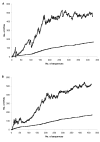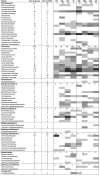Diversity and seasonal dynamics of bacterial community in indoor environment
- PMID: 18397514
- PMCID: PMC2323381
- DOI: 10.1186/1471-2180-8-56
Diversity and seasonal dynamics of bacterial community in indoor environment
Abstract
Background: We spend most of our lives in indoor environments and are exposed to microbes present in these environments. Hence, knowledge about this exposure is important for understanding how it impacts on human health. However, the bacterial flora in indoor environments has been only fragmentarily explored and mostly using culture methods. The application of molecular methods previously utilised in other environments has resulted in a substantial increase in our awareness of microbial diversity.
Results: The composition and dynamics of indoor dust bacterial flora were investigated in two buildings over a period of one year. Four samples were taken in each building, corresponding to the four seasons, and 16S rDNA libraries were constructed. A total of 893 clones were analysed and 283 distinct operational taxonomic units (OTUs) detected among them using 97% sequence similarity as the criterion. All libraries were dominated by Gram-positive sequences, with the most abundant phylum being Firmicutes. Four OTUs having high similarity to Corynebacterium-, Propionibacterium-, Streptococcus- and Staphylococcus- sequences were present in all samples. The most abundant of the Gram-negative OTUs were members of the family Sphingomonadaceae, followed by Oxalobacteraceae, Comamonadaceae, Neisseriaceae and Rhizobiaceae. The relative abundance of alpha- and betaproteobacteria increased slightly towards summer at the expense of firmicutes. The proportion of firmicutes and gammaproteobacteria of the total diversity was highest in winter and that of actinobacteria, alpha- and betaproteobacteria in spring or summer, whereas the diversity of bacteroidetes peaked in fall. A statistical comparison of the libraries revealed that the bacterial flora of the two buildings differed during all seasons except spring, but differences between seasons within one building were not that clear, indicating that differences between the buildings were greater than the differences between seasons.
Conclusion: This work demonstrated that the bacterial flora of indoor dust is complex and dominated by Gram-positive species. The dominant phylotypes most probably originated from users of the building. Seasonal variation was observed as proportional changes of the phyla and at the species level. The microflora of the two buildings investigated differed statistically and differences between the buildings were more pronounced than differences between seasons.
Figures




References
-
- Wilson M. Microbial inhabitants of humans Their ecology and role in health and disease. Cambridge; Cambridge University Press; 2005.
-
- Bornehag CG, Sundell J, Bonini S, Custovic A, Malmberg P, Skerfving S, Sigsgaard T, Verhoeff A. Dampness in buildings as a risk factor for health effects, EUROEXPO: a multidisciplinary review of the literature (1998–2000) on dampness and mite exposure in buildings and health effects. Indoor Air. 2004;14:243–57. doi: 10.1111/j.1600-0668.2004.00240.x. - DOI - PubMed
Publication types
MeSH terms
Substances
LinkOut - more resources
Full Text Sources
Molecular Biology Databases

